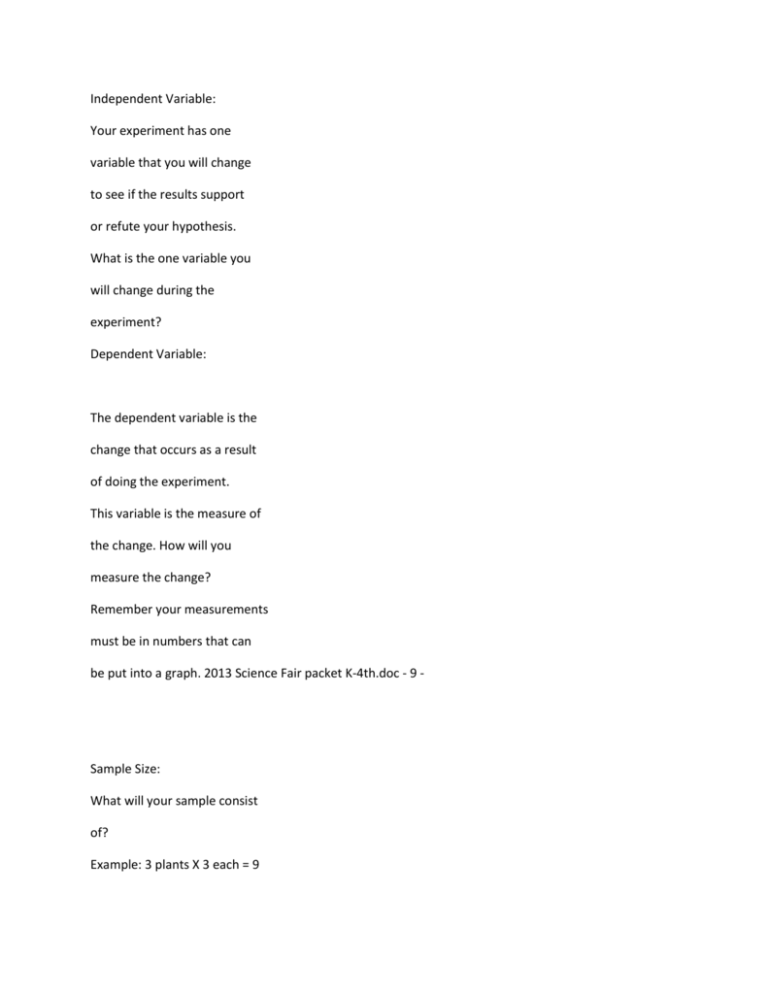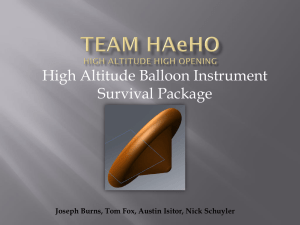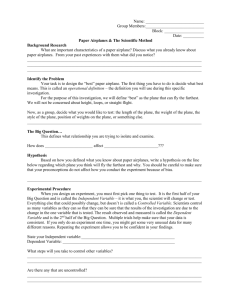Independent Variable: Your experiment has one variable that you
advertisement

Independent Variable: Your experiment has one variable that you will change to see if the results support or refute your hypothesis. What is the one variable you will change during the experiment? Dependent Variable: The dependent variable is the change that occurs as a result of doing the experiment. This variable is the measure of the change. How will you measure the change? Remember your measurements must be in numbers that can be put into a graph. 2013 Science Fair packet K-4th.doc - 9 - Sample Size: What will your sample consist of? Example: 3 plants X 3 each = 9 total plants Repeated Investigation: How many times will you repeat the experiment for accuracy? experiment needs to be done at least 3 times. Controlled Variable(s): Which variables will you control or keep the same during your experiment? . Independent Variable: The independent variable is the amount of air you put in the balloon. This is the independent variable because in my experiment, I change the amount of air that I put in each balloon. 2. Dependent Variable: The dependent variable is the distance traveled by the hovercraft. This is the dependent variable because the distance traveled is affected by the air in the hovercraft’s balloon. 3. Control Variables: The control variables in this experiment are the travel surface, hovercraft, and the fans providing thrust. These need to be controlled, or the experiment will not be even. There are three types of variables that must be considered when determining the procedure to be followed: " Independent variable – the factor that you will change on purpose during the experiment to find out what effect it has on something else. Example: different types of materials (silk, felt, canvas, paper, tissues, etc.) to construct a parachute to observe the effect the type of material has on the drop time of the parachute " Dependent variable – the factor that is observed and measured to see if it is affected by the change made in the independent variable. Example: The dependent variable in the parachute investigation would be the time the parachute took to drop. " Control /Constant variables – the factors in the experiment that must be kept exactly the same to make sure that they are not having any effect on the dependent variable. They ensure that you are conducting a fair test. Example: Variables that would need to be controlled in the parachute experiment would be the size of each parachute made, the same mass tied to the parachute, and the height the parachute were dropped from. There are three types of variables to consider when designing the investigation procedure. • The independent variable is the one variable the investigator chooses to change. • Controlled variables are variables that are kept the same each time. • The dependent variable is the variable that changes as a result of /or in response to the independent variable. Having students talk through the investigation will help them to clarify the different variables involved in the experimental design. What factors will change? What factors will stay the same? A hands-on way to introduce a fair test is to ask students, “Who can make the best paper airplane?” Once two students are selected to compete, hand one a large piece of construction paper and the other a piece of regular copy paper. Students will immediately note that this is “unfair.” If we want the test to be fair, only the paper airplane design can be different. Everything else, including how hard the airplane is tossed, must be the same. Design Experiment Once students formulate a hypothesis for their investigation, they must design a procedure to test it. A well-designed investigation contains procedures that take into account all of the factors that could impact the results of the investigation. These factors are called variables. There are three types of variables to consider when designing the investigation procedure. • The independent variable is the one variable the investigator chooses to change. • Controlled variables are variables that are kept the same each time. • The dependent variable is the variable that changes as a result of /or in response to the independent variable. Having students talk through the investigation will help them to clarify the different variables involved in the experimental design. What factors will change? What factors will stay the same? A hands-on way to introduce a fair test is to ask students, “Who can make the best paper airplane?” Once two students are selected to compete, hand one a large piece of construction paper and the other a piece of regular copy paper. Students will immediately note that this is “unfair.” If we want the test to be fair, only the paper airplane design can be different. Everything else, including how hard the airplane is tossed, must be the same. Step A – Clarify the variables involved in the investigation by developing a table such as the one below. Testable Question What is changed? (independent variable) What stays the same? (controlled variables) Data Collected (dependent variable) What can be measured?










